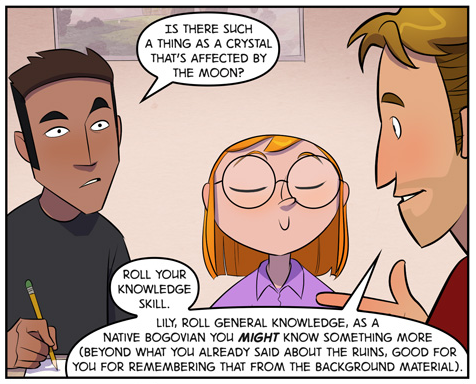Nadav’s words on this week’s page are basically just answers to three different “info-giving” checks that he asked for on the previous page.
 Generally speaking, I think that when the GM asks for a player to roll an “info-giving” check, they should base it heavily on one of the distinct features of the character, preferably one that the player chose during character creation, or after.
Generally speaking, I think that when the GM asks for a player to roll an “info-giving” check, they should base it heavily on one of the distinct features of the character, preferably one that the player chose during character creation, or after.
Or in other words: Whatever way a player decided to build his character, that should be the lens through which they gain info about the world.
For example, Guy took Knowledge (Science), so Nadav tells him to roll that.
Lily chose to be Bogovian, so Nadav tells her to roll General Knowledge (basically, your Smarts).
After that, to make sure everyone gets something, he asks Rotem to roll her Spirit, which isn’t a normal “info-giving” Trait, but she chose to make this her highest Trait, and Nadav only wants her to access knowledge she already had and simply forgot about its importance.
Nadav then continues to give each of the players a unique piece of information, that is heavily coloured by the character feature he decided to build upon.
There are four main reasons to do any of this.
Rewarding Player Mechanical Choices
Frankly, this whole article is just a specific case of this single gigantic principle – whatever rules-related choice a player made should be rewarded by the GM. In this case, the reward is information, that only you could gain, thanks to that specific choice you made during character creation (or advancement). This has three huge benefits:
First, it keeps the player feeling useful, because they contribute in a way only they can, and make them feel their character is helpful and fun to play.
Second, it gives the rules meaning and importance, making sure the player pays attention to them.
Third, it reinforces the players trust in their GM, since the GM is showing they care about the players’ choices, and really, in games, choices are everything.
Focusing the Lens
The imaginary world is conveyed to the players through the GM’s descriptions, and it’s easy to sometimes just give The Truth as it is. “No, there’s no secret door on that wall.” That’s okay, but it’s almost always better to give the characters’ perception of The Truth, instead. Just like in the real world, where we can only access the objective reality through epistemological— Yes, well, the thing is, The Truth is immutable, and therefore boring, while perception leads to drama.
You might not notice something that’s there, or think you notice something that isn’t there; and whatever it is you notice will be coloured through the lens of your many, many fallacies as a sentient being. All of us are bigoted in some ways, lacking experience in various fields, and suffer from tons of biases. In the real world, that’s something many of us try to overcome in order to avoid drama and danger. In the imaginary world, let’s do the opposite!
“You don’t notice any secret door on that wall, there are none of the usual hidden Bogovian hand-holds.” — “Have I noticed something else?” — “Nothing else seems out of place, no.”
Are there really no secret doors on that wall? Or is it my subjective view – my lack of skills or experience, my tiredness, my contempt to Bogovians – that made me miss the secret door that’s actually there?
In many situations, this sort of question can be a useful thing to implant in a player’s mind.
Controlling Information
Let’s say Rotem wants to see what Muna knows about a piece of fabric inlaid with a Fjordstadian family symbol, that the party found in a scene of a crime. She rolls, the dice explode like crazy, and she gets 36 raises.
Well.
Does that mean she knows everything there is to know about the subject? If she rolled Knowledge (Fjordstadian Dynasties), then yes, probably. But if she rolled anything else, she should only gain information relevant to her character build.
This is important, because “everything there is to know” might be enough to overcome any and all obstacles in the story, especially if the adventure has an investigative vibe. Why should they go to search the crypts for the ancient family name, if Muna just knows it? But if she only knows that the fabric is a part of a funeral blanket, used in Fjordstadians burial, that would be enough to push the story forward, without jumping to the end.
The raises, of course, should not be ignored – the player earned them. They should be used, however, to supplement the next phase of the story, such as by allowing Muna to also realise the fabric has a strange scent, thus giving a warning about the lethal gas trap in the crypts. You know what, with 36 raises, she even recognises the specific plant the poison is made of (seeing as she a Masian tribal princess with Survival), and has some antidote on her.
Enriching the World
Finally, when you have to colour the information in specific hues, you usually have to add some cultural background or details in general, and both are good things.



